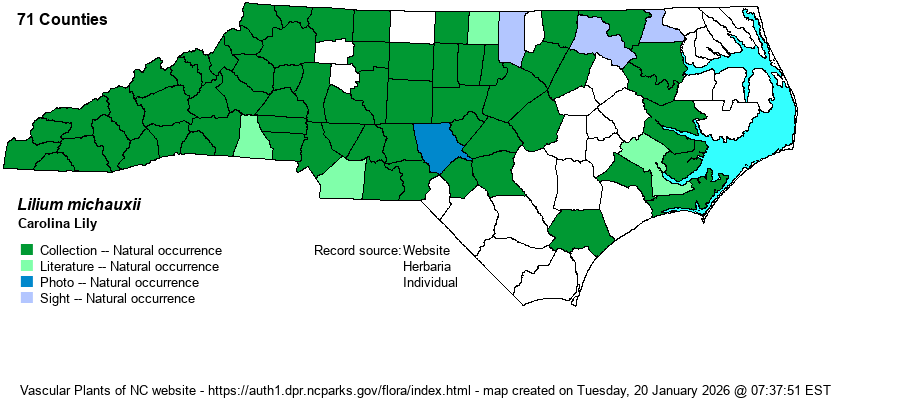| Author | Poiret | |
| Distribution | Though the distribution is nearly statewide -- the only Lilium species that is found in most of the state -- there are a number of gaps in the range in the Coastal Plain. It may well be absent in the far northeastern counties (east of Hertford and Beaufort counties), and possibly in some counties in the far southern portions. Certainly is present in all counties in the Mountains and Piedmont.
This is a Southeastern species that is actually more prevalent in the Piedmont province than in the Coastal Plain and Mountains. It ranges north to southern VA and eastern TN, and south to the FL Panhandle and eastern TX. It is likely more widespread in NC than in any other state in its range. | |
| Abundance | Fairly common and widespread (found in all counties) in the Mountains, infrequent to fairly common in the Piedmont, and uncommon in the western Coastal Plain, including the Sandhills region. Mostly rather rare elsewhere in the central Coastal Plain, and very rare to absent in the far east and far south parts of the province. | |
| Habitat | This is a Lilium of dry to mesic shady and semi-shady places instead of open damp or wet ground. It is most frequent in upland hardwood or mixed forests, often on ridges or upper slopes. Farther eastward into the Coastal Plain it is more often found in somewhat better drained soils, as it does not do well in the sandy soils of the Sandhills. Thus, it is most prevalent in Dry-Mesic Oak-Hickory Forests, Montane Oak-Hickory Forests, and the drier portions of Mesic Mixed Hardwood Forests. It also inhabits roadsides and powerlines. | |
| Phenology | Blooms in July and August, and fruits in September and October. | |
| Identification | This is the Official State Wildflower owing to its widespread occurrence in the state and its showy flower on such a small plant. It grows to about 2 feet tall, often just 1-1.5 feet in drier sites, and has just one to a few flowers at the end of the stem. It has 3-7 whorls of leaves along the stem, and each of the 5-6 leaves in a whorl is quite thick and obovate (wider toward the tip than the base), averaging 3 inches long. The 6 tepals are bright orange (usually) and are so strongly recurved as to touch in the back of the flower; the entire flower is about the size of a baseball, and always droops to essentially face downward. The stamens extend 2 inches or more beyond the tepals. This species is a somewhat smaller version of the more northern L. superbum, but that species grows to head height or taller, has many more flowers on a stem, and has narrower leaves that are widest in the middle. This species is more often found with just a single basal leaf, which can be confused with several other "liliaceous" species. These are juvenile plants, which may take several years to finally send up a flowering stalk. Though it is quite widespread in our upland hardwood forests, you may have difficulty finding one in bloom, as they flower in a short period in midsummer and as the majority of plants seen simply are not in bloom. Also, you seldom can find more than just 3-5 plants in bloom on a given walk, and thus though recorded from 2/3rds of the counties in the state, it is always a thrill to stumble onto one in bloom. | |
| Taxonomic Comments | RAB (1968) states that "The plants in bogs tend to be more robust and resemble L. superbum than the plants of upland habitats". This statement relates to the newly described L. pyrophilum, as L. michauxii is not found in bogs or other wetlands.
| |
| Other Common Name(s) | Michaux's Lily | |
| State Rank | S4 [S4S5] | |
| Global Rank | G4G5 | |
| State Status | | |
| US Status | | |
| USACE-agcp | FAC link |
| USACE-emp | FAC link |

